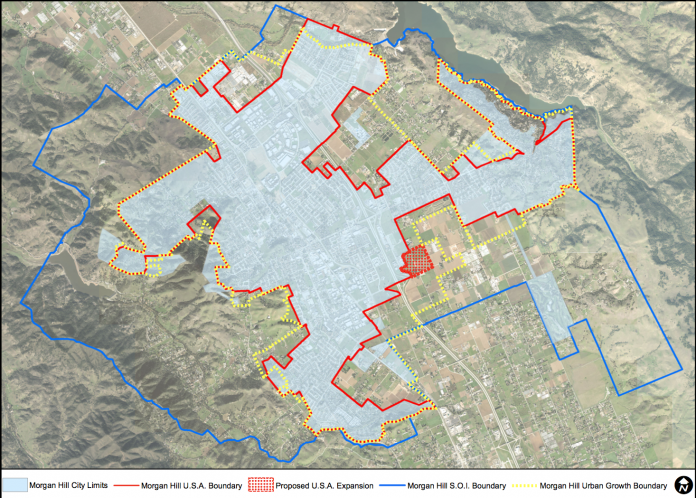A Catholic high school has been talked about in the Morgan Hill for nearly a decade, but the Diocese of San Jose has run into a series of setbacks getting its 40 acres of land—their preferred site of the future school—annexed into the city.
The latest of these hurdles is the denial of an annexation proposal Dec. 5 by the county commission charged with authorizing city boundary line extensions.
The school site sits outside of the city’s Urban Services Area, so it must be annexed in order to receive city services like water, sewer and public safety. The area the city attempted to annex sits North of Tennant Avenue and East of Condit Road.
Plans to annex the high school site were submitted by the City of Morgan Hill to the Local Agency Formation Committee (LAFCO) for a second time, resulting in a Dec. 5 ruling at the committee meeting.
Committee staff had recommended in their report that LAFCO commissioners deny the city’s request, because staff believed the plans did not comply with committee standards. The annexation proposal failed in a 5-2 vote, with Santa Clara County Supervisor Mike Wasserman and Santa Clara Valley Water District Director John L. Varela voting to approve the city’s request.
Morgan Hill and the LAFCO committee have a complicated history when it comes to the Catholic high school project and what is designated as the city’s “Southeast Quadrant.” Many of the commissioners at the Dec. 5 meeting brought up past decisions by the committee to deny the city’s annexation requests in the area that is mostly farmland.
LAFCO is an appointed body of citizens and elected officials throughout the county. The committee’s mission is, “Encouraging orderly boundaries, discouraging urban sprawl, and preserving agricultural and open space lands.”
The annexation is considered critical to the success of the Diocese’s plans for Catholic high school in Morgan Hill. The City Council voted in September with a 3-2 vote to send the plans to LAFCO for approval. Council members Rich Constantine and Rene Spring voted against the plans.
Spring has marked his tenure by being an anti-growth advocate. Constantine previously said he could not vote to approve the plans because he did not feel it had been improved since the last time it was submitted, two years ago.
In 2016, LAFCO denied an annexation request—also submitted by the City of Morgan Hill—for a large portion of the Southeast Quadrant with a 5-2 vote. The city then submitted a request to annex only the land for the South County Catholic High School. The request was denied in June 2016.
The original request was part of a plan to annex most of the Southeast Quadrant bound by Tennant Avenue to the south, Murphy Avenue to the west, Barrett Avenue to the north and abutting an agricultural field to the east. This land has been identified in the county’s agricultural plan as “prime agricultural land.”
The request presented to the committee at the Dec. 5 meeting included 66 acres of land, nearly 40 of which would be used for the high school. Committee staff recommended denial of the annexation request based on several points of the plan they said violate LAFCO standards.
The LAFCO staff report said there was land available within Morgan Hill city limits as an alternate site for the school; the annexation wouldn’t create logical city boundaries; there would be a significant impact to agricultural land; the city didn’t have the infrastructure to provide the public safety, sewer, water and storm drainage to the area; the plan isn’t consistent with the regional transportation plan; the city hasn’t annexed all of the unincorporated land still within the urban service area; and the plan wasn’t consistent with county policies.
The Dec. 5 meeting was tense, with reports and comments from LAFCO staff being contradicted by Morgan Hill city staff’s presentation. Commissioner Sergio Jimenez said, when attempting to make his decision, “You all are viewing things much differently.”
A major topic of discussion was the designation of the parcels as “prime farmland.” Morgan Hill farmers made public comments about the quality of land in the annexation site and said it was not suitable for long-term farming use.
George Chiala Jr. of Chiala Farms told the commission his family had trouble in the past farming on the land. “That land isn’t good farmland—if you need data to prove that I can provide it,” said Chiala. “If we can’t do it, it’s going to be hard for somebody else to do it.”
Still, many commissioners said it would be against LAFCO standards to approve the annexation. Commissioner Rob Rennie said the answer wasn’t black and white to him, but he didn’t feel Morgan Hill had the proper plans in place for the annexation.
“These kind of annexation plans would be called sprawl,” Rennie said before eventually voting down the annexation plan.
While many of the commissioners saw the annexation request as the beginning of more outward growth in Morgan Hill, Wasserman thought the annexation would be the best way to preserve agricultural land.
Wasserman told the rest of the commissioners that if the request was not approved, the Diocese would sell the land and the parcels would be used for individuals or families who build what is often referred to as “ranchettes” or “McMansions.”
He thought mitigation that was planned for by the Diocese and the city—the two chief proponents of the Catholic high school proposal—would be the best way to guarantee the land was used for agricultural purposes and not development.
“I thought this was an opportunity to bring a school and protect ag land,” Wasserman told the Times.
Communications and Engagement Manager for Morgan Hill, Maureen Tobin, told the Times that the city does not currently have any plans in place following the denial of the annexation request.








